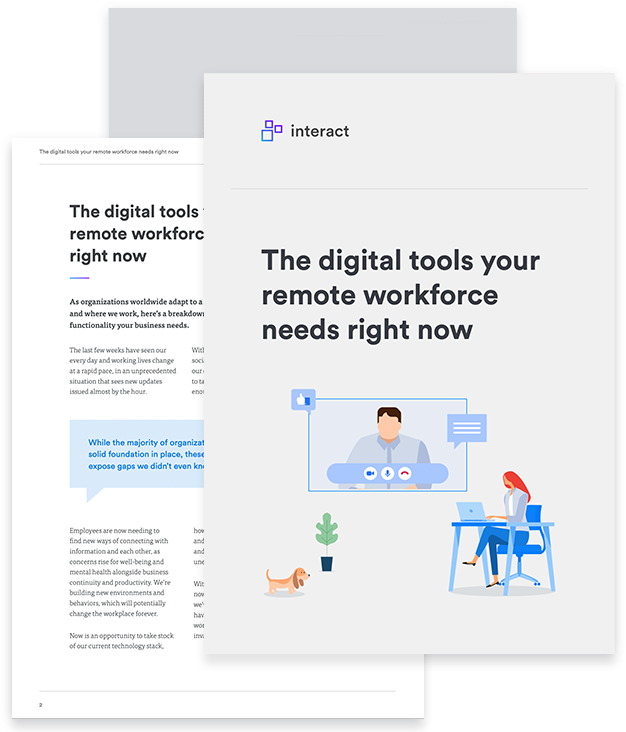The coronavirus pandemic has pushed the internal communications function into the spotlight and provided a much-needed seat at the table. But what happens next for the profession?
Times of change or crisis often see Internal Communications come into its own.
While the value of the profession has been on the upward trend over the past decade, the pandemic response has accelerated its advancement: rapidly. Never before has the demand and importance of clear, effective, and informative internal communication been so critical.
Now ranking on the management agenda for most CEOs, internal communication is being thrust into the spotlight. IC teams tasked with responding to the crisis are playing a leading role not only in delivering crucial leadership messaging but in shaping it: given a voice in critical discussions and strategic decision-making.
The first phase of the response has been intense and continually changing. It’s pushed through new methods, channels, and audience demands at pace. The messaging has changed almost daily – even several times a day. Internal Communications has had to remain quick on its feet, rising to challenges we’ve never seen outside the ‘worst-case scenario’ crisis comms plans stashed in back-office cabinets.
But as we move into the second phase – one set to span several months, and likely in a wave pattern rather than a linear one – what will happen to the role and responsibilities for internal communications?
What are the next priorities for the profession, as global economies begin to ease out of lockdown?
The digital tools your remote workforce needs
The role of internal communications during ‘phase one’
The Institute of Internal Communications (IoIC) conducted a survey to gauge the impact of the COVID-19 crisis on the profession. Its results show the scale of demand and change we see anecdotally first-hand.

Unsurprisingly, 71% of respondents saw a significant increase in workload and capacity in the immediate response phase.
Among the increased responsibilities, internal communications were tasked with distributing the initial crisis and public health response in line with government recommendations, outlining changes as lockdown rolled out, and the initiation of remote working and communicating new processes to maintain business continuity.
A focus on staff wellbeing and productivity has seen a roll-out of engagement, mental health, and ‘morale boost’ communications, designed to combat isolation and connect staff to their organization and one another.
Providing that essential link saw a 49% improvement in employee engagement with comms; by combining accessible corporate messaging with digital tools for employees to connect, we’ve seen a measurable impact on morale.
83% of internal communicators feel the crisis has positively impacted trust in communication as a result; 90% believe it will have a positive (58%) or very positive (32%) impact on the profession as a whole.
In fact, research by Edelman shows that ‘my employer’ is the most trusted institution by individuals when it comes to a source for information about the crisis, over and above government and media sources.
In eight out of 10 countries surveyed, “my employer” is seen as better prepared for the virus than “my country.” This finding is confirmed by the high trust in “my employer” to respond effectively and responsibly (62 percent) to the virus.
The added value of organizational respect for the function and a large-scale experiment in remote working now means Internal Communications has an irrefutable business case for the right technology and the function as a whole.
What happens next?
The term, ‘the new normal’ is now echoing across industries worldwide, as many nations come out the other side of the peak and begin easing lockdown restrictions. But what is the ‘new normal?’ And what does it mean for internal communications?
This second, more prolonged phase is expected to last until a vaccination is available, something many leading scientists don’t believe will come into widespread circulation until 2021.
However, it doesn’t mean we’re facing a prolonged state of lockdown. Instead, the focus is on containing and managing the spread: enabling early detection, reporting, and isolation of new cases, and reducing the risk of a ‘second wave’.
In practical terms, despite differences between countries or regions, this will be in the form of a gradual, phased reopening of public life and economies, with added measures to prevent spread.

The ‘new normal’ will naturally differ by industry, and many expect it to deliver several additional, smaller ‘waves’ of COVID-19 as social distancing measures lift. There may be further shorter or regionalized lockdowns where cases spike.
Organizations will need to redefine their working models and service provision and ensure they can continue to operate with additional safety measures in place.
While some office spaces will reopen, the return will likely be phased. Research also suggests there will continue to be widespread remote working models in place long after the crisis subsides, as many reap the benefits. It will take time to reach pre-COVID productivity or demand levels – for some industries, there may be a lasting impact that will forever change how they operate.
The ‘new normal,’ then, isn’t going to look like it was pre-COIVD-19.
The digital tools your remote workforce needs
What are the priorities for Internal Communications in ‘phase two’?
It may be easy to assume that Internal Communications can ‘hang up their hats’ as the first crisis phase draws to a close, but in fact, the function will be even more critical over the coming months. We can’t lose our momentum or afford to become complacent: if anything, internal communication will be the essential foundation of how we navigate what comes next.

The ‘new normal’ will be a significant change management project for all industries, both public and private sector. Internal Communications has both a responsibility and an opportunity to make a difference in its roll-out.
As we move forward, organizations will need:
- Continued and frequent communication of the ‘return to work’ or ‘new normal’ processes and what that looks like for our organizations
- Coordination of the reopening and increase of global operations
- Change and continuing evaluation of new protocols and procedures for safe working, ensuring these are communicated to staff effectively and all issues addressed
- Establish in-house detection, reporting, and isolation protocols for new cases among employees or the supply chain
- A re-evaluation and fine-tuning of internal communications and employee lifecycle tools and processes to meet the demands of a long-term remote workforce
- To check-in and listen to employees as part of the process of change
- Sustained visibility of leadership and a focus on re-building/sustaining organizational cultures
- To demonstrate corporate citizenship as both staff and wider communities adjust; whether that’s through support and flexibility around financial health, childcare, or charitable support
Right now, we don’t necessarily have all the answers or information we need. As with phase one, organizations and Internal Communications will need to remain agile and continue to learn and evolve as they go. Staff will continue to look to their employers as a source of trust for clarity around government updates and changes.
Organizations and Internal Communications will need to remain agile and continue to learn and evolve as they go.
It’s also important that we build on those tools, processes, and channel changes rolled out during phase one. Many were deployed under intense time and resource pressures, designed to meet an immediate need. As our audience needs change and the ‘new normal’ takes hold, it’s time to identify and plug the gaps, refine the overall experience, and ‘fine-tune.’
What must internal communications functions do?
As with any significant organizational change, Internal Communications must approach the next stage with careful planning and understanding of audience needs. Outside of ‘crisis response mode,’ now is the time to invest in longer-term and strategic thinking around how best to support your organization and its employees.

If you have an existing internal communications plan, it’s time to revisit and revise it, aligning with the exceptional circumstances we can expect in the coming months. This can be broken down into the following eight focus areas:
#1. Key stakeholders
Establish who needs to be involved in defining, shaping, approving, or delivering internal communications going forward. Contingencies for absence, should senior representatives need to isolate or are unwell, should factor into this list.

Do you have an existing ‘rapid response’ team? Are the representatives in it still the right stakeholders, should a further lockdown phase or spike in cases occur?
Determine not only how stakeholder needs now differ from before, but their capacity to contribute as they respond to the new pressures of reopening or reestablishing ‘business as usual’ practices. Although this next phase will spread over several months, things will frequently change: requiring quick decision making and response cycles.
The digital tools your remote workforce needs
#2. Key activities
What activities or campaigns can you use to deliver information or change comms to your workforce? Look not only as those campaigns that have worked well in recent months but if they still have value in the newer circumstances.
Many organizations have moved from daily status updates to weekly, for example; initial FAQ or feedback channels for staff may be replaced with bi-weekly pulse surveys to gauge sentiment, while leadership updates need to step up as changes roll out.
If you have existing activities lined up in your comms plan that are considered non-critical or surplus to organizational needs, given the current circumstances, consider benching these – or re-defining how they look to make them relevant to staff.
#3. Goals and objectives
Longer-term objectives such as driving employee advocacy or pushing up your eNPS score may need to take a backseat. Get your organizational response right at this point, and you’ll reap the rewards in other ways long-term in any case.
Consider what you need to get across to employees and how you want them to respond – whether that’s through action or sentiment. Look back to those organizational priorities for phase two and set out specific goals your comms needs to achieve. How do they align with overall business objectives for the coming months? How can your efforts support this further?
#4. Resource & budget

Understandably, many organizations have pulled back non-essential budgetary spend against the economic uncertainty of COVID-19. However, survey results show us the board-level understanding of the value of internal comms is at an all-time high.
Assessing your cost structure and resource requirements to meet goals – even if this is through third-party or part-time resource – may be needed. Building a business case for additional support may seem daunting in the current climate, but given the significant role IC has to play, it’s justified.
The digital tools your remote workforce needs
#5. Key messages and stories
You’ve defined your goals and objectives, but it’s essential to break that down into the key messages you’re looking to get across to employees. This may be the details of new procedures or protocols for working, or the support on offer from your organization, for example.

Consider what message should be company-wide or tailored to specific employee groups, who owns or should be the ‘face behind’ those messages, and drill down into what falls under the ‘need to know’ and ‘useful to know’ to ensure you’re not overwhelming employees. Prioritize for each moment.
#6. Communication tools and channels
The rise of video conferencing and virtual meetings reflects our changed models of working since the outbreak. Organizations and individual employees alike are trialing new platforms and ways to connect, adapt BAU processes, or obtain and share information. Re-assessing your digital workplace and the channels used to reach employees will be a big part of your plan.
Although most communicators will likely have already adapted to new tools or methods, we must continue to evaluate their reach, success, and value as changes roll out. How will staff access information during each stage of the next phase? Which channels can be improved or utilized more effectively? Are there opportunities you’re missing?
The digital tools your remote workforce needs
#7. Target personas
The circumstances, roles, and needs of your internal audience have shifted significantly in recent months. They’ll change further still as we move through the next phase.
Take the time to understand how their needs differ, their primary concerns or challenges, how they’ll consume information, and which points along the next phase will be most important to them.

Go beyond basic demographics – such as department or location – and consider those more niche persona groups we’re seeing in the wake of the crisis, such as furloughed staff, working parents, or those with high-risk or key worker family members. Even bullet-pointed ‘key considerations’ for each persona can ensure your comms hit the right spot going forwar
#8. Track and measure
The appreciation of Internal Communications may be on the up, but this doesn’t remove the need to define and track success or outcomes.

Doing so not only enables us to demonstrate value to the C-suite and back business cases for continued investment; it ensures we’re learning and adjusting our approach as we go. Metrics such as employee trust in leadership, sense of feeling informed about change, or the number of health and safety concerns will now outrank traditional benchmarks such as employee Net Promoter Scoring or engagement.
Although there are many elements to consider, keeping your new internal communications plan simple will not only help you get up and running, but mean you’re able to adapt and evolve it as the situation develops.
Most importantly, take the time to listen to those you’re looking to reach: your employees. Making assumptions about staff needs can undermine communications efforts as key messages are misinterpreted or deemed inappropriate at a particular moment.
Top takeaways for internal communicators
The strategic role and organizational value of Internal Communications is on the rise; efforts during phase one have shown its vital importance. We have our ‘seat at the table’, and the need for clear, effective, and continuing communication is clear.

Phase two will undeniably bring a new wave of demand and challenges. However, the impact goes far beyond this.
Internal Communications has helped shape the organizational response to the coronavirus pandemic. How we interact with staff directly influences our employer and external brand; how we’re perceived, our ability to continue delivering vital products and services, or operate under extraordinary conditions. Internal communication is a driving force behind productivity, morale, engagement, customer service provision, health and safety management, and much more.
Those actions we take today will have a lasting impact for many, many years to come.
In turn, informed, engaged, and loyal staff transfer those same attributes to our customers and consumers. They’ll drive and support our recovery.
In the months and years to come, both staff and consumers will reflect on how organizations responded to their employees’ needs in the wake of the coronavirus pandemic. It will become a defining benchmark for employers and brands alike.
Those internal communicators who have risen to the challenges and opportunities offered by these circumstances will continue as strategic partners in effective employee lifecycle management long-term. We can expect a growth in roles and responsibilities continuing long after the impact of the pandemic eases.
Perhaps the most vital takeaway is to remember that those actions we take today will have a lasting impact for many, many years to come.



